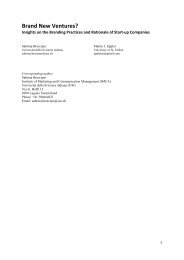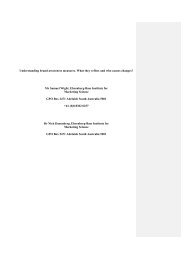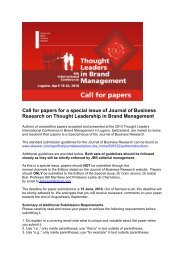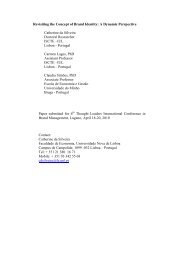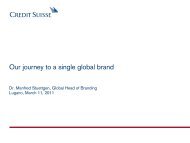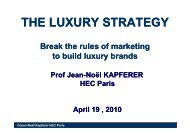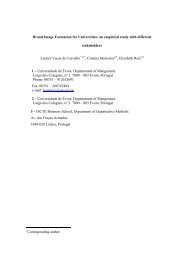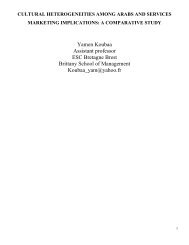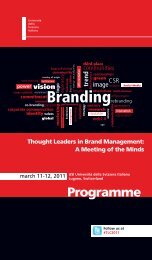Esch, Franz-Rudolf, Winter, Kai, Limited Editions
Esch, Franz-Rudolf, Winter, Kai, Limited Editions
Esch, Franz-Rudolf, Winter, Kai, Limited Editions
Create successful ePaper yourself
Turn your PDF publications into a flip-book with our unique Google optimized e-Paper software.
ehavioural tendencies which help to regulate arousal and result from the motivation forstimulation seeking (Raju, 1980). Exploration tendency is a temporary relatively stablepersonality trait with varying intensity between individuals (Baumgartner and Steenkamp,1996; Grande, 2005; Joachimsthaler and Lastovicka, 1984; Van Trijp et al., 1996). It issupposed that there are different levels of optimal stimulation among individuals (Hebb,1955; Leuba, 1955; Maier et al., 2007). Exploration seekers show a high optimum. They willsearch more likely for stimulation than exploration avoiders, who are characterised by a loweroptimum respectively a preference for familiar stimuli and situations (Baumgartner andSteenkamp, 1996; Raju, 1980; Van Trijp et al., 1996). As a result of the exploration tendency,explorative behaviours aim at the variations of the consumers’ surrounding attractions andact as a stimulant to the organism (Baumgartner and Steenkamp, 1996; Berlyne, 1960; Raju,1980). Van Trijp et al. (1996) show that explorative behaviour is expected particularly inthose product categories with low product involvement (Hoyer and Ridgway, 1984). Becauseof their extraordinary characteristics limited editions in FMCG-categories are expected toshow a particularly high potential for stimulation. Therefore, they may primarily meet theacceptance of exploration seekers.Scarcity heuristics: Several authors discuss the question to what extent scarcity as aheuristic cue has a positive impact on product evaluation (“scarcity effect”) (Cialdini, 1993;Lynn, 1989, 1992; Stock and Balachander, 2005). Cialdini (1993; 2001) assumes a“scarce = attractive”-heuristic, with consumers drawing direct conclusions from scarcity toattractiveness (Cialdini, 1993; 2001). The information about limited product availabilityinitiates a standardised, cognitively hardly controlled sequence of behaviour which causes alonging for the product (Cialdini, 1993). According to Lynn (1992), scarcity is not directlyresulting in increased attractiveness. In fact, consumers use a “scarce = expensive”-heuristicand infer from limited availability to a higher price (Lynn, 1992). An increase inattractiveness due to scarcity may be expected only if consumers prefer costly products ratherthan cheap alternatives, e.g. to demonstrate higher status. Concerning limited editions inFMCG-categories, it can be assumed that consumers will take the indication of limitedavailability as a heuristic stimulus as well. However, it is unlikely that one of the abovedescribed heuristics will be activated. The arousal of a desire for the product “at the push of abutton” is contradictory to other views about scarcity effects. According to several authors(e.g. Brannon and Brock, 2001; Brehm, 1966; Folger, 1992; McConnell et al., 2000;Zeelenberg and Pieters, 2007), cognitive processes are fundamental for increasedattractiveness caused by scarcity. This is contrary to Cialdini’s (1993) assumption. However,effects shown by Lynn (1992) are primarily expected in high involvement product categorieswhere products serve as status symbols (Lynn, 1989). Concerning FMCGs, a scarcityinformation may rather lead to a “scarce = novel”-heuristic. This heuristic assumes thatconsumers learn about the limited edition characteristics of novelty and speciality in FMCGcategories. Therefore, consumers draw conclusions from limited availability to the offers’distinctiveness. In turn, depending on individual tendencies to exploration, this leads toincreased perceived product attractiveness.Categorisation: Categorisation-theoretic considerations provide conclusions about reciprocaleffects of limited editions towards the parent brand. The process of categorisation containsthe identification of an object as a member of a class of objects on the basis of similarities(Ozanne et al., 1992; Pavelchak, 1989; Rosch and Mervis, 1975). A brand category can beunderstood as a group of several distinguishable products bearing the same brand name(Boush, 2001; Boush and Loken, 1991). Similar to categories in general, the members of abrand category show a graded structure. “Some products are more representative of a brandcategory than are others” (Boush and Loken, 1991). All of a brand’s existing products as wellas new ones can be described in terms of how much they are (a)typical for the brand (Joiner4



